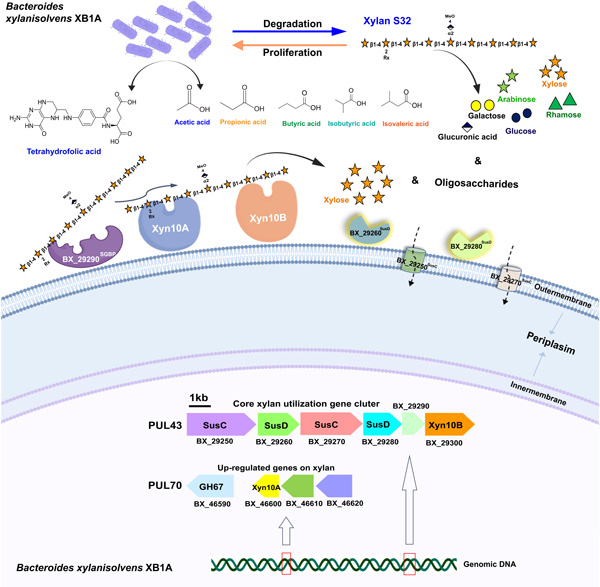Research Reveals How Bacteroides Xylanisolvens Survives in Human Gut
Xylan is crucial for shaping the composition of human gut microbiota. Although Bacteroides spp. devote 20 % of their genome to encode the polysaccharide utilization loci (PULs) to degrade glycan, the further function of PULs largely lag behind. Bacteroides xylanisolvens spp. XB1A (BX) is a xylan degrading bacterium isolated from human faeces. It has been reported that BX is a potential strain to therapy nonalcoholic steatohepatitis (NASH) and xylan has the bioactivity on chronic metabolic disease. However, whether xylan is degraded by BX to function and the functional mechanism of xylan is still vague. Hence, it is crucial to firstly clarify the molecular mechanism of xylan degradation by human gut microbiota.
In a study published in Carbohydrate polymers on May 19, a team of researchers led by DING Kan from Shanghai Institute of Materia Medica (SIMM) of the Chinese Academy of Sciences, in collaboration with groups led by ZHANG Zhenqing from Soochow University, revealed the underlying molecular mechanism of degradation of xylan from Dendrobium Officinale by human gut Bacteroides spp.
Combined with molecular biology, biochemistry techniques and bioinformatics could reveal the degradation of xylan by BX. In brief, this study showed that xylan S32 promoted the proliferation of BX which could degrade the xylan S32 into monosaccharides and oligosaccharides. Meanwhile, BX utilized xylan S32 to generate SCFAs and tetrahydrofolic acids. In the degradative process, two discrete PULs including PUL43 and PUL70 were involved. The researchers demonstrated that BX_29290SGBP was a novel surface glycan binding protein (SGBP) which was essential for the growth of BX on xylan S32. Xyn10A and Xyn10B were two endo-xylanase which could cleave the backbone of xylan S32 to produce D-xylose and oligosaccharides.
This study firstly demonstrated how human gut BX degraded xylan in molecular level. These results provide new evidence to understand the food source of BX and the BX-directed intervention strategy by xylan.

Degradation mechanism of xylan by human gut Bacteroides xylanisolvens XB1A (image by DING Kan’s laboratory of SIMM)
DOI: https://doi.org/10.1016/j.carbpol.2023.121005
Contact:
DIAO Wentong
Shanghai Institute of Materia Medica, Chinese Academy of Sciences
E-mail: diaowentong@simm.ac.cn




